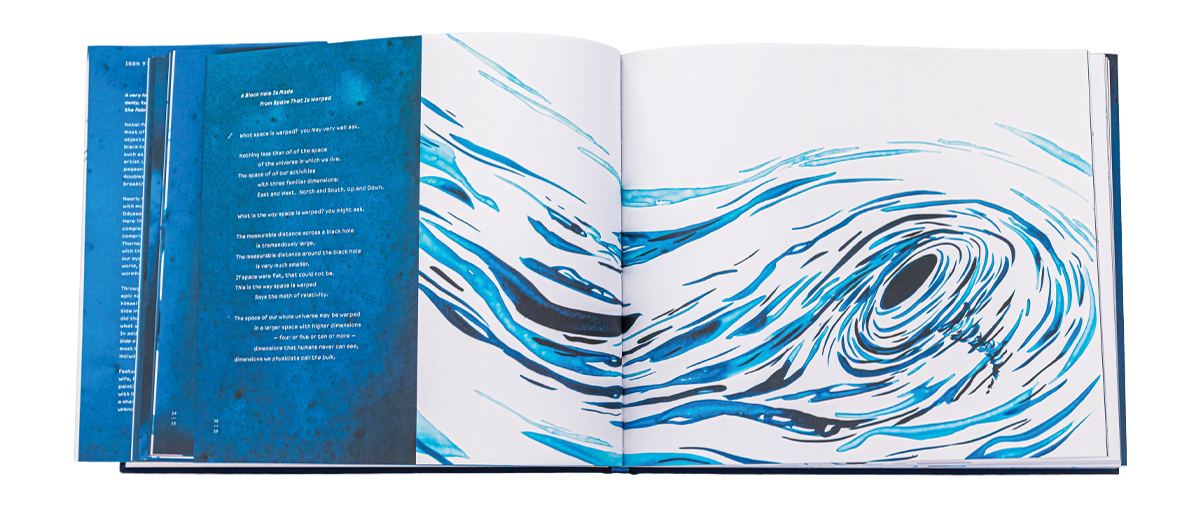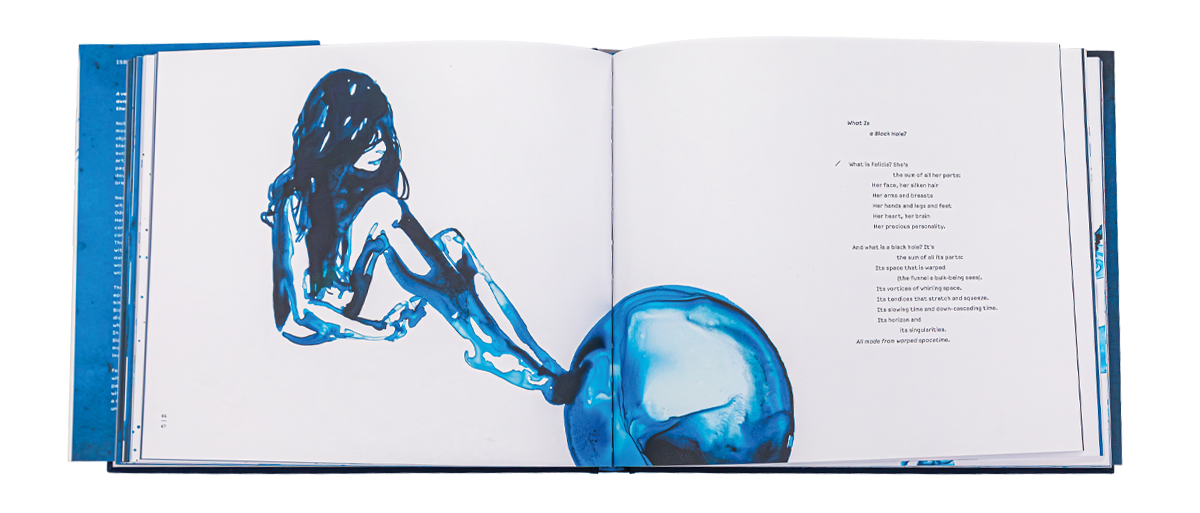
In their new book, an artist and a theoretical physicist bridge the complexity of physics with the wonder of discovery in some of the weirdest corners of the cosmos.
LIGO was co-founded 40 years ago by Kip Thorne, the 2017 Nobel Prize-winning physicist and Feynman Professor of Theoretical Physics Emeritus at Caltech. In 2010, Playboy magazine commissioned an article by Thorne. He suggested the topic of “The Warped Side of the Universe,” which would be based on objects and phenomena made from warped space-time, with art by Associate Professor and Chair of the Art Department Lia Halloran. The article didn’t pan out as planned; as Thorne and Halloran describe it, “Lia’s depiction of [the female figure] was not up to the ‘Femlin standard’ that Hefner required for Playboy women.” However, the experience led to a longstanding collaboration between Halloran and Thorne, whose creative synergy has come to resemble a unique cosmic force itself.
Thirteen years later, that would-be article expanded to become the book “The Warped Side of Our Universe: An Odyssey Through Black Holes, Wormholes, Time Travel, and Gravitational Waves” (Norton/Liveright, 2023). Told through poetic verse written by Thorne and tightly integrated into original art by Halloran, “Warped Side” explores discoveries in the field of astrophysics from the past decade, including black holes, wormholes, bizarre flows of time and the birth of the universe.
For the project, Halloran created over 500 ink works on drafting film, approximately 150 of which ended up as final paintings in the book, which also features four double-sided gate folds that extend out to over two feet. The book’s main character is a spacetime traveler named Felicia, who is modeled in body and spirit on Halloran’s eponymous wife. This choice was intentional. The collaborators didn’t want to write a didactic book about physics; they wanted to provide an entry point to those complex ideas in a way that is accessible to anyone. “The book exposes us to black holes in an intimate and sensual way, through the writing and the paintings and who even appears in the book,” says Halloran. “We aren’t trying to teach about black holes. We’re offering a way to have an intimate and engaging experience of the universe.”


Nobel Prize-winner Kip Thorne (left) and Associate Professor and Chair of the Art Department Lia Halloran began collaborating 13 years ago.
“The Warped Side of Our Universe” includes poetic verse written by Kip Thorne and approximately 150 paintings by Lia Halloran.






Orbiting an Idea
As an artist, Halloran is known for works that merge art and science. Her unique style often incorporates elements of photography, drawing and painting, inspired by celestial phenomena, and considers themes of exploration, human curiosity and our place in the vastness of space.
Halloran’s cognitive process and creative practice enable an interdisciplinary approach to her art. “My studio functions like a laboratory,” she says. “It starts with a question, and then we orbit around that question from multiple perspectives.”



Artist and Associate Professor and Chair of the Art Department Lia Halloran in her studio.
Consider the concept of “Up.” In 2015 Halloran began learning to fly a Cessna 172. “As I was flying, I was thinking through the physics and the feeling of being unbounded by the Earth,” she recalls. This contemplation led to the creation of a piece titled “Double Horizon,” an immersive three-screen video installation, shot over two years during the course of more than 30 flights. Halloran describes the video as a “double portrait” — of the city of Los Angeles and as a self-portrait of the artist in the cockpit flying above the city. The art investigates how space can be experienced differently when there are shifts in perception, time and scale. An ArtCenter article published in advance of the 2020 exhibition at the college’s Peter and Merle Mullin Gallery notes that in “Double Horizon,” “Halloran traverses the landscape in
ways most won’t and asks the viewer to reflect on the poetic nature of the body’s relationship to its environment. (“Double Horizon” had a four-month run at the San Francisco Exploratorium museum in 2022, as well as in several other solo exhibitions.)
This experience of learning to fly also led to a course called “Up,” which Halloran co-taught with Claudine Jaenichen and Anna Leahy, both professors in Chapman’s Wilkinson College of Arts, Humanities, and Social Sciences.
“The idea for the course was, because so many of us are fascinated by being ‘up,’ we can build a class from the perspective of physics, design, writing, art, history and future dreaming. We take the concept, circle around it, and engage all the disciplines,” Halloran says.
Clips from Lia Halloran’s video installation “Double Horizon.” Watch the full video plus additional content here.

Halloran brings ideas from her work as an artist into the classroom, and many of her Chapman students have become longtime studio assistants. Adam Ottke ’13 was among the students who took the course “The Intersection of Art and Science” over a decade ago, and he worked on image handling and color correction for the final version of “The Warped Side of Our Universe.” “I was always interested in interdisciplinary study, in science and math,” says Ottke, who also has his own photography studio. “Lia showed us, in the real world, how science and art can coexist and inform one another.”
Jen Seo ’14 took the same course over a dozen years ago. She has assisted in Lia’s studio on an early layout draft of “The Warped Side,” the series “Deep Sky Companion,” which is permanently installed at Caltech in Pasadena, and the early testing of large-scale cyanotype prints in the series “Your Body Is a Space That Sees.” “What’s great about Lia is that when she gets excited about an idea, she doesn’t just silo away. For most artists, it’s lonely work. But she will take the idea and bring people in, start conversations,” says Seo. “She brings her ideas to the class—they guide what she’s teaching. And that creates a community on campus, and it invites us into her world.”
Bodies in Space
In 2014, Halloran created a travel course titled “The Origins of Art and Science,” in which students spent three weeks during the Interterm session in Florence, Italy, to study the interconnection of the arts and science during the Renaissance. “Alchemy, the fountains of medical schools, collecting of objects from the natural world — this all plays into how we understand science now,” she says. In another course, “The Intersection of Art and Science,” Thorne took the class to visit a prototype of LIGO at Caltech in Pasadena.
For Halloran, teaching is an extension of her studio practice. She brings ideas from the studio into the classroom and invites students to participate in her thought processes and art.
Halloran credits Chapman’s unique environment for her ability to design and teach courses that follow an interdisciplinary mode of inquiry. “Chapman has enabled such autonomy and interdisciplinarity. President Daniele Struppa and Wilkinson College Dean Jennifer Keane have really fostered this,” she says. “But the culture of interdisciplinarity also emanates from faculty across the college and the students themselves.”

Lia Halloran in her studio.
An exhibition of artwork from the book will be up from Nov. 4 to Dec. 23 at the gallery Luis De Jesus Los Angeles. You can see more of Halloran’s work and a list of public speaking events to celebrate the launch of the book at www.liahalloran.com or on Instagram @liahalloranstudio.
Kip Thorne and Lia Halloran will be in conversation with Chapman President Daniele C. Struppa about the book at Chapman University in the Folino Theater on Feb. 19, 2024, at 7 p.m.
Original art from “The Warped Side of the Universe: An Odyssey Through Black Holes, Wormholes, Time Travel, and Gravitational Waves” by Kip Thorne and Lia Halloran. Text Copyright © 2023 by Kip Thorne. Illustrations Copyright © 2023 by Lia Halloran. Used with permission of the publisher, Liveright Publishing Corporation, a division of W. W. Norton & Company, Inc. All rights reserved.
 Photos by Adam Hemingway
Photos by Adam Hemingway